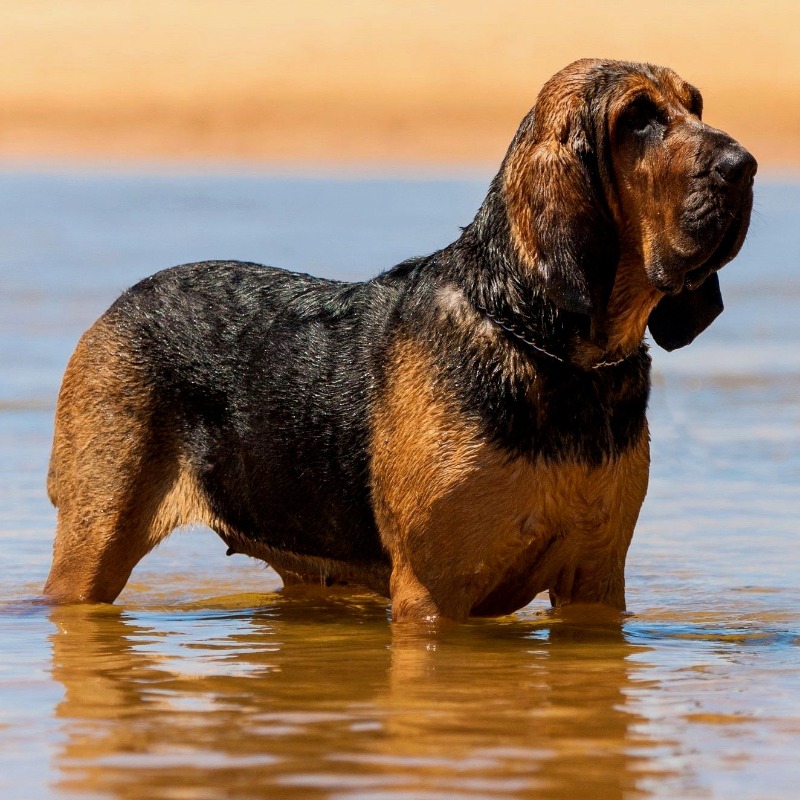Breeds
Bloodhound

GROUP 4 - HOUNDS
Brief History
They have a history that extends back to the 7th century AD in Belgium and France. Today's Bloodhounds are descended from those hounds, bred by Hubert, a 7th-century monk who later became patron saint of hunters, and from hounds bred by other medieval noblemen who kept scent hounds as hunting dogs. The breed is renowned for its extraordinary scenting and tracking ability and is able to follow a trail up to several days old with remarkable results.
Average Life Span
When considering a dog please realise that you are taking it on for its lifetime.
The average life span is 8 to 12 years.
Temperament
Affectionate, a little reserved and sensitive, solemn, easy going with dogs and people. Bloodhounds are pack hounds and should be easy-going, an affectionate and extremely gentle hound. They can, however, be reserved with strangers.
General Breed Description
The Bloodhound is very powerful and stands over more ground than is usual with hounds of other breeds. The skin should be surprisingly loose and velvety, especially around the head. The ears are long, low, and soft. The deep lip continues into loose folds of skin, the flews, which themselves merge into folds of dewlap under the jaw and neck. This excess skin – and the slobber that accumulates on it – helps to trap the scent particles. The pendulous ears, far longer than the muzzle, sweep the scent toward the large nostrils.
The breed can be rather stubborn and Obedience training should be started early, practised regularly, and made as much fun as possible. The Bloodhound is easily distracted, and training should be kept short, especially whilst young. While it’s beautiful to watch the breed’s head go down and its tail go up, as it picks up a scent trail, it’s important to note it can be almost impossible to call a Bloodhound back. The breed needs to be on-lead for any exercise taking place outside a secure area, as that wonderful nose it is known for often leads to trouble.
The breed’s colours are black and tan, liver and tan, and red. A small amount of white is permissible on the chest, toes and tip of the tail.
Coat and Care Requirements
The coat is smooth, short and weatherproof and easily maintained. Regular baths, especially in the summer months, and weekly grooming with a rubber mitt will keep your Bloodhound in good shape. Bloodhounds find having their nails trimmed particularly unpleasant, so it’s advised that they are done routinely each fortnight from a very early age, otherwise it can become quite problematic. Those long ears and deep folds need daily attention. Wearing a snood at meal times can assist with messy ears & regular drying under the neck & dewlaps goes a long way to keeping fungal infections away.
Size
Height: Males 63 to 69cms (25 to 27ins), Females 58 to 63cms, (23 to 25ins).
Health
All breeds have individual health issues. When speaking to breeders it is recommended you enquire about breed’s health and what health testing the breeder does. The bloodhound is generally a healthy breed, however health conditions do occur occasionally. Eye problems such as Entropion & ectropion can be a problem for the breed and like most deep chested dogs, bloat can be a concern. Hip and Elbow Dysplasia can affect the breed and all reputable registered breeders should be health testing their breeding animals through the ANKC ORCHID scheme. Along with the hip & elbow testing, cardiac screening by a Cardiologist (echo preferred – breed can be affected by SAS) should be carried out & DNA testing for DM – Degenerative Myelopathy. Skin problems can also occur in the breed, due to the abundance of skin folds, so daily management is advised.
Suitability
The Bloodhound is usually very good with families (care should be taken with toddlers, as they can potentially knock them over) and other animals; however, the breed is not for everyone. Young dogs can be extremely clumsy around the house and as an adult they can hurl slobber for metres, even reaching the ceiling. Bloodhounds require a fully fenced yard, with a minimum height of about 5ft, and regular daily exercise.
In Conclusion
Now you know a little more about this breed. If you have decided this is the dog for you and wish to investigate further, please contact the Breed Club or Dogs Victoria. They will be able to give you information about available puppies and also suggest dog events where you can see the breed and speak to breeders. In this way you will gain a better perspective of the breed and its needs. With any breed of dog, it is important to research and determine suitability for your lifestyle before committing to a puppy which will be a part of your family for many years to come.
Whilst many breeds are recommended for families, it is imperative that when children are with dogs they are supervised at all times. Basic obedience training is a vital part of dog ownership.
Dogs Victoria is about the responsible ownership of all dogs and in particular the preservation of pure breeds.
Link to Dogs Australia Breed Standard https://dogsaustralia.org.au/breed/detail/132
Breeders
Sorry, there are currently no breeders advertising for this breed. If you are a registered Dogs Victoria breeder and wish to advertise here please create an advertisement here.



